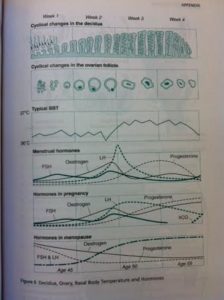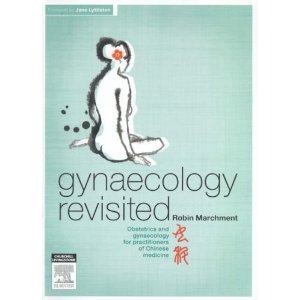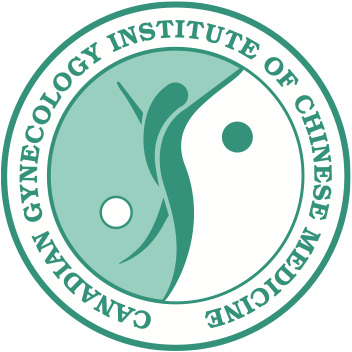Menstrual Phases: East and West
The key to a woman’s health is their menstrual cycle. Menstrual symptoms such as irregularity, bleeding problems, and PMS signs are largely indicative of specific underlying conditions. Sometimes the mechanism of menstruation can be a bit confusing. Basically, the first half of the cycle – the estrogen dominant half – is the Yin phase. The yang phase is the second half of the cycle when progesterone is the dominant hormone. Let’s take a look at some basic correlations:
|
TCM & WM Correlations
|
|
TCM
|
WM
|
| Balance of Kidney Yin & Yang |
Effects of Estrogen on FSH release, ultimately effecting release of LH & progesterone |
| Mutual generation of Yin & Yang |
Stimulatory, positive feedback system in endocrine system |
| Mutual control of Yin & Yang |
Inhibitory, negative feedback system in endocrine system |
And let’s take a look at menstrual phases by looking at the menstrual cycle week by week.
|
Week 1: Menstruation
|
|
TCM
|
WM
|
- Chong Meridian fills with Blood and delivers it to the uterus
- Liver activates the Ren Meridian so that it releases Blood to the uterus
- There is a gradual consumption of Blood and subsequently Qi due to menstruation
|
- Day 1: shedding of old endometrium
- Day 2-6: regeneration of basal layer of endometrium
- FSH stimulates growth & recruitment of follicles
- Follicles secrete moderate amount of estrogen, which by the end of the week inhibits the secretion of FSH & LH
- Day 5-8: a dominant follicle (Graafian follicle) grows, the rest die off.
|
|
Week 2: Post Menstrual Phases
|
|
TCM
|
WM
|
- More Qi & Blood consumption as Spleen, Heart & Kidney build more Blood & Yin to replenish the empty Chong Meridian
- By the end of week 2, Yin is full and turns into Yang (LH surge, ovulation)
|
- Dominant follicle grows and produces more estrogen
- Endometrium thickens in preparation for fertilized ovum
- Cervical glands produce fertile mucus
- Estrogen levels peak at day 12 (pre-ovulatory drop in temperature)
- Cervical os widens, cervix is raised
- High levels of estrogen trigger release of GnRH, which triggers FSH & LH surge
- At the peak of the surge, the ovum is released into the fallopian tube (ovulation)
- Empty follicle becomes progesterone excreting corpus luteum (Yin à Yang)
- Progesterone:
- Inhibits FSH & LH and therefore further ovulation
- Causes cervical os to close and mucus to thicken
- Relaxes uterine muscles, cervix drops
- Raises basal body temperature
|
|
Week 3: Post Ovulatory Phases
|
|
TCM
|
WM
|
- Yang Qi takes over
- Heart, Spleen & Kidney Yang produce Blood and consolidate Ren to support fertilization and implantation
- Chong is primed and consolidated to nurture conception
- Ren + Kidney Yang support the pregnancy
|
- Decline of FSH & LH
- Increase of Progesterone and Estrogen
- Progesterone triggers endometrium to secrete glycogen to support and nourish blastocyst
|
|
Week 4: Pre-Menstrual Phases
|
|
TCM
|
WM
|
- Yang continues to grow, reaches its peak and turns back into Yin, and the start of a new cycle
- Qi & Blood are full and the uterus overflows
|
- Progesterone peaks at the beginning of week 4
- If conception has not occurred:
- Corpus luteum degenerates
- Ovarian hormones decrease, increase in endometrial hormones causes rupture of endometrial structures and shedding
|
And here’s a pictorial view:

Menstrual Phases. Page 209. Marchment, Robin. (2007). Gynaecology Revisited: Obstetrics & Gynaecology for Practitioners of Chinese Medicine. Elsivier: Churchill Livingstone. Marrickville, NSW.
Regulating the menstrual cycle means to regulate a woman’s health. It’s about the balance of Yin and Yang – or hormones. This section has largely been brought to you by Robin Marchment and her book Gynaecology Revisited: Obstetrics & Gynaecology for Practitioners of Chinese Medicine. Or you can visit her website here.

Caroline Prodoehl, R.Ac, R.TCMP
References:
Marchment, Robin. (2007). Gynaecology Revisited: Obstetrics & Gynaecology for Practitioners of Chinese Medicine. Elsivier: Churchill Livingstone. Marrickville, NSW.


